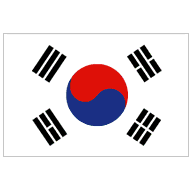North and South Korea webpage by Ken, Kathy,
Loretta, Ron
|
|
|
The Korean Peninsula has been inhabited since paleolithic times, and Korean historians trace the ethnic roots of the Korean people at least as far back as the pottery-using cultures of the fourth and third centuries B.C.. Early tribal groups formed numerous federations, and over the centuries these combined into larger state-like entities. Sometime before the fourth century B.C., at least one of these entities had begun to refer to its leaders by the Chinese title for king, wang. Three of these states, boasting an aristocratic social structure and centralized institutions of government, had come to dominate Korea by the early centuries of the present era, conducting trade and intermittent warfare with each other and with China. Stretching down from Manchuria in the north was the kingdom of Koguryo; in the southwest and southeast, respectively, the kingdoms of Paekche and Silla held away. Korean political, cultural, and linguistic unity dates back to the unification of these three kingdoms under Silla in the seventh century A.D., making Korea, despite its present temporary division into two states, one of the oldest unified nations in the world.
More Historical background and timeline
NORTH and SOUTH: At the end of World War II, the US and the Soviet Union agreed that US troops would accept the surrender of Japanese forces south of the 38th parallel and the Soviet Union would do so in the north. In 1948, the UN proposed nationwide elections; after P'yongyang's refusal to allow UN inspectors in the north, elections were held in the south and the Republic of Korea was established. The Democratic People's Republic of Korea was established the following month in the north. Communist North Korean forces invaded South Korea in 1950. US and other UN forces intervened to defend the South and Chinese forces intervened on behalf of the North. After a bitter three-year war, an armistice was signed in 1953, establishing a military demarcation line near the 38th parallel. The North's heavy investment in military forces has produced an army of 1 million troops equipped with thousands of tanks and artillery pieces. Despite growing economic hardships, North Korea continues to devote a significant portion of its scarce resources to the military.
|
|
|
|
||||||||||||||||||||||||||||||||||||||||||||||||||||||
|
|
|
||||||||||||||||||||||||||||||||||||||||||||||||||||||
|
|
|||||||||||||||||||||||||||||||||||||||||||||||||||||||
|
|
|
|
|
|
|
||||||||||||||||||||||||||||||||||||||||||||||||||
|
||||||||||||||||||||||||||||||||||||||||||||||||||||||||
|
|
||||||||||||||||||
|
Important issues for CLAD
·
Websites for Korean Americans for education and community
· Stanford Korean American Student Association
· Yale University - Korean American Students at Yale - promotes political, cultural, and social interests of the community of Korean Americans at Yale.
National Korean American Service & Education Consortium, Inc. (NAKASEC) - focuses on civil rights, eduication, and community advocacy.
|
|
· Korean American Student Association
Korean American Education & Psychology Information Center.
Edu Info Korea. English (.) Korean (.) Discussion BB(K/E)>> Edu Info
(USA)(K) Child...
The Impact of Cultural Diversity
If you have ever traveled to a foreign country, you noticed differences in behaviors, attitudes, dress, language, and food. In fact, part of the fun of traveling is in discovering the differences in culture.
Even though we usually think
of cultural differences as being mostly national differences, there is probably
as much cultural diversity within the United States as between the United
States and other industrialized nations.
The life of a middle-class family in the United States or Canada is
probably more like that of a middle-class family in Italy, Ireland, or Israel
than it is like that of a poor family living a mile away. Yet while we value cultural differences
within our own society. Our tendency is
to value characteristics of mainstream, high-status groups and devalue those of
other groups.
By the time children enter
school, they have absorbed many aspects of the culture in which they were
raised: the language, attitudes, ways of behaving, food preferences, and so
on. Many of the behaviors associated
with being brought up in a particular culture have important consequences for
classroom instruction. For example, the
school expects children to speak standard English. This is easy for students where standard English is spoken but
difficult for those whose families speak other languages or significantly
divergent dialects of English. The
school also expects students to be highly verbal, to spend most of their time
working independently, and to compete with other students for grades and
recognition. However, many cultures
within our society value cooperation and peer orientation rather than
independence and competitiveness. Since
the culture of the school reflects mainstream middle-class values most children
from a different culture are often at a disadvantage. Understanding the backgrounds from which students come is
critical for effectively teaching them both academic material and the behaviors
and expectations of the school.
It is our hope that the use
of this webpage will help you have a better understanding of an Asian cultural
group that is growing in population yet the schools focus more on the Chinese
and Southeast Asian populations.
Other resources
Here are some websites into
the Korean Language
writing
Another sample is http://www.korea.com








